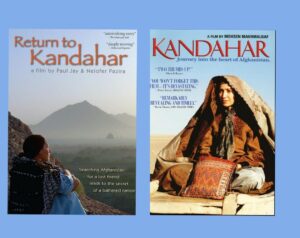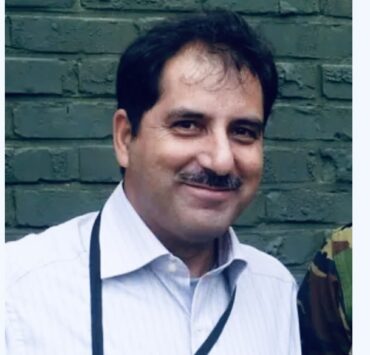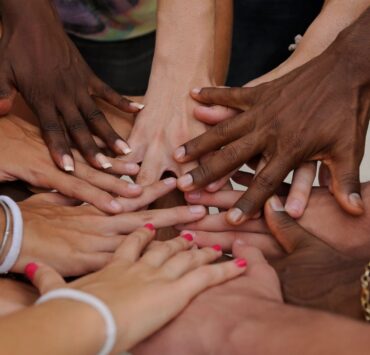
By Ammu Joseph

The Network of Women in Media, Bangalore, burst back into life this weekend after a period of relative inactivity with a public screening of two films: Kandahar and Return to Kandahar, in collaboration with Pedestrian Pictures, a collective of young film-makers and enthusiasts who use the medium to promote thinking and action on current events and issues and regularly screen a wide range of films in the city.
Both groups were taken aback at the tremendous public response to the screening, with over 150 people cramming the hall (some sitting on the floor and standing along the walls) and nearly 50 others leaving their names and contacts for information about a promised second screening.
Contributory passes priced at Rs 30 each were sold to facilitate and support the construction of a check dam in Kasipur, Orissa. The adivasi movement there, Prakrutik Sampark Surakhya Parishad, has provided stiff resistance to the Orissa government’s decision to lease land to transnational corporations for mining operations in the area. Kasipur has often been at the centre of public attention for the starvation deaths of adivasis year after year. Constructing the check dam is part of their efforts to prove to the government that the solution does not lie with increased industrialisation but in localised development of resources in the area. Thanks to the generosity of several members of the audience, who contributed extra money towards the cause, the total collection for the evening was beyond anybody’s estimate — a total of Rs 6180!
The videotapes were made available to the NWMB by Nelofer Pazira, the Afghan-Canadian journalist who stars in the Iranian feature film, Kandahar, directed by Mohsen Makhmalbaf, and made the documentary film, Return to Kandahar, along with Paul Jay.
Set on the Iran-Afghanistan border, Kandahar follows the journey of a young Afghani-born woman, Nafas (played by Pazira), a former refugee returning home after living in Canada for many years to look for her sister, who had recently sent word that she was in deep despair and contemplating suicide. Having lost her legs to a land mine, the young woman had been abandoned by her family in Kandahar where, as a woman alone, she is essentially property, now discarded and unprotected, and left without hope.
The semi-documentary film, performed by nonprofessional actors, is partly based on Pazira’s experience. Her own family moved to Canada from Afghanistan in 1989 when she was 16. When, in the late 1990s, she learned that a childhood friend was suffering under the Taliban, Pazira attempted to find her by contacting the revered Iranian filmmaker, Makhmalbaf, in part because his 1987 film, The Cyclist, portrayed Afghan refugees sympathetically. Though he was unable to help Pazira cross into Afghanistan, he suggested that they publicise the situation by making the film, Kandahar.
The result is an incredible journey from the Iranian-Afghani border town, Niatak, across the Dashi e Margo desert to Kandahar. Donning the requisite burkha (through which the camera looks repeatedly, to remind you of what she sees and doesn’t see), Nafas meets various characters, witnesses numerous wretched situations, and speaks her reactions into a tape recorder, as if articulating them will make sense of the experience.
Return to Kandahar, a documentary placed in continuation to the feature film, has Pazira returning to her native Afghanistan in the hope of tracking down her childhood friend, Dyana. The search takes her to the cities of Kabul, Kandahar and Mazar-e-Sharif and is central to the unraveling of both her personal past and the unfolding of history in Afgahnistan.
Six months after the so-called liberation of Afghanistan in December 2001, she discovers a country where local anarchy, “warlordism,” and occupation by foreign military forces in their “war on terror” shatter hopes for peace and stability. This new Afghanistan is a violated land, where a thousand Dyanas are lost in rubble, dust and memory.
Pazira’s epic journey across a broken land smashed by war with the Russians, years of anarchy under the “Northern Alliance,” the Taliban and now by America’s “war on terror” turns the pages of history in her country. Her reflections on the current situation —partly in dialogue with co-director Paul Jay and with the use of archival footage —show an Afghanistan that stands in stark contrast to the present.
Apart from Pazira’s bold interview with General Abdul Rashid Dostum, another memorable scene that shows her in a journalist role has her vociferously arguing with young men trying to prevent her from interviewing women students in the name of Afghan culture, pointing out that the young women were educated and could decide for themselves whether or not they wished to speak to her. When the chief spokesperson of the conservative male point of view finally turned away in defeat, there was a spontaneous round of applause from the Bangalore audience.
Pazira’s film serves as a vivid reminder of the sad fact that the situation in Afghanistan today is still extremely grim, with some indications that the Taliban may well be gaining ground again. Unfortunately, with the focus of the world’s superpower as well as much of the media having shifted to Iraq, Afghanistan’s enduring problems have more or less slipped out of public consciousness.
Take, for example, the situation of Afghan women. Although the bombing of Afghanistan in October 2001 as part of the US-declared “war on terror” piggybacked on the need to liberate the country’s suffering women, newly discovered by “the international community,” a number of reports by women’s organisations, human rights organisations and the media over the past couple of years have indicated that Afghan women are not dramatically better off now than before the so-called liberation of themselves and their country.
Although the new constitution adopted earlier this year has been widely acclaimed as a victory for women, because it upholds equal rights and duties before the law for all citizens and prohibits discrimination, several critics have warned that it contains some sections that can potentially, once again, undermine Afghan women’s rights.
Apart from that, as Meera Nanji, a film-maker working on a documentary about the lives of three Afghan women (View from a Grain of Sand), has observed, “For most women life has not changed much since the ousting of the Taliban. While ostensibly there are increased opportunities: women can go to school, receive health care and gain employment, in reality few women can take advantage of these possibilities and they are largely restricted to Kabul. According to the many aid workers and Afghan women that I spoke to, women continue to be very fearful of the armed US-backed mujahideen who exert control over much of the country. Most women, even in Kabul, still wear the burqa (the head to toe garment that covers the whole body) as a protective measure against public humiliation and physical attack. The U.N and international human rights groups recently released reports detailing increased incidents of beatings, kidnappings and rape by U.S-funded regional warlords and their militia, stating: ‘local militia commanders violate women’s rights and commit sexual abuse with impunity.’
“In addition, women are still subject to the demands of their husbands or male relatives, many of whom do not want to grant them any degree of independence. Women face a lack of choice in their personal lives and vocation; forced and under-age marriages are common, and education for girls is still contested.
“The Ministry of Women’s Affairs, ushered in with much fanfare by the U.S and the U.N., is of little help in advancing women’s rights. Many believe it exists largely in name to keep international donors happy. With an ill-defined mandate, it has no legal jurisdiction and no implementation power. Additionally, many women working in the Ministry are from the elite and deeply conservative themselves, with little interest in changing the status quo.” (Znet.com, Los Angeles Times, Sydney Morning Herald, December 29, 2003)
A report by Amnesty International, released in October 2003, documents Afghan women’s continuing concerns about widespread domestic violence, forced marriage and rape by armed groups. According to Amnesty, “Two years after the ending of the Taliban regime, the international community and the Afghan Transitional Administration (ATA), led by President Hamid Karzai, have proved unable to protect women.
A report by Human Rights Watch, released exactly a year ago, in July 2003, documents army and police troops kidnapping Afghans and holding them for ransom in unofficial prisons; breaking into households and robbing families; raping women, girls and boys; and extorting shopkeepers and bus, truck and taxi drivers. The report also describes political organizers, journalists and media editors being threatened with death, arrested and harassed by army, police and intelligence agents. The subject area of the report, the southeast of Afghanistan and Kabul city, is one of the most densely populated areas of Afghanistan.
According to the report, because soldiers are targeting women and girls, many are staying indoors, especially in rural areas, making it impossible for them to attend school, go to work, or actively participate in the country’s reconstruction. In many places, human rights abuses are driving many Afghan families to keep their girls out of school. The atmosphere of violence, along with resurgent religious fundamentalism in parts of the country, is endangering the most important human rights improvement since the end of the Taliban —the ability of girls to go back to school. “The fact is that most girls in Afghanistan are still not in school,” says Brad Adams, executive director of the Asia Division of HRW.
The situation of Afghan media is not much better. On World Press Freedom Day in May 2003 Human Rights Watch had warned that press freedom in Afghanistan was under assault, with attacks and threats against local journalists having increased sharply in the preceding weeks.
In November 2002 Reporters Sans Frontieres (Reporters Without Borders) had published a detailed report on the situation of the press in Afghanistan. According to RSF, “the situation of press freedom is still fraught in certain provinces such as Herat, where governors and warlords control almost all the news media and sometimes use force to muzzle journalists who criticise their power. The central government seems for the most part unable to stop these abuses, which have rarely been denounced by the United Nations.”
In a paragraph that should be of particular interest to women in the media, the RSF report says, “Since setting up in the Panshir valley north of Kabul, those in charge of Radio Solh (Radio Peace) have been the target of threats and intimidation from local commanders, especially Rasoul Sayef. One of the station’s directors, Zakia Zaki, a woman, was threatened with death at the time of the station’s installation in the city of Jebel-e-Sharat. Since then, the station’s women reporters have been unable to work freely in the city. The local chiefs of Jamiat-e-Islami (a member of the Northern Alliance) have forbidden them to interview other women in the street.”
Although the Indian media, like much of the world media, seem to have forgotten Afghanistan, there is plenty of information on the Net for anyone who is interested in keeping abreast of developments in the unfortunate country. The website of the Revolutionary Association of the Women of Afghanistan (www.rawa.org) is a popular one that has relevant links to others. And for those interested in a more academic assessment of the economic situation in Afghanistan, the latest Country Profile on the website of the International Development Economics Associates (https://www.networkideas.org/country/country.htm) focuses on Afghanistan.
Since one of the characters in the film, Kandahar, is a foreign doctor trying to help people in war-torn Afghanistan, this passionate statement by David Hayman, another good Samaritan on his return from the country in 2003 has particular resonance:
“I have just returned from the last country we went to war with, barely 16 months ago, Afghanistan. I spent a month there taking in medical aid to 13 mountain villages that collectively go by the name of Sheik-Jalaal. Out of a population of 5000, 50 per cent were children and they were dying. Dying of tuberculosis, diphtheria, malaria, whooping cough, gastroenteritis, and URI. They haven’t seen a doctor in 24 years! I arranged and paid for teams of doctors, nurses, and drivers. I bought thousands of pounds worth of medicines, and the Halo Trust (the mine-clearing organisation) loaned me a fleet of two ambulances and two Land Rovers…
“At the end of the day, though, what I managed to achieve was but a sticking-plaster on the wounds of that beleaguered and forgotten country. Wasn’t this the country that Tony Blair and George Bush pledged, in the same breath that announced war, that the people of Afghanistan would not be forgotten? Well, I can say after two visits to Afghanistan that they are not only forgotten but well and truly betrayed. The country is on its knees: roads, bridges, tunnels, schools, homes, hospitals, and farmlands are reduced to rubble and dust. It is one of the most heavily land-mined countries in the world. Only 5 per cent of the rural population have access to clean water, 17 per cent have access to medical services, 13 per cent have access to education, 25 per cent of all children are dead by the age of five. Life expectancy is 43. An estimated three million people are still in refugee camps in Iran and Pakistan, let alone the hundreds of thousands of internally displaced peoples. This country is in a mess and if anyone tells me that millions of dollars worth of aid is getting into this country then I will gladly take them to Afghanistan and point out the brutal truth. The people are dying! And we are turning a blind eye.” (The Herald, Glasgow, 26 February 2003)
18 July 2004




